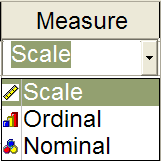What is the difference between nominal, ordinal and scale?
In SPSS, you can specify the level of measurement as scale (numeric data on an interval or ratio scale), ordinal, or nominal. Nominal and ordinal data can be either string alphanumeric) or numeric but what is the difference?
1. Nominal.
A variable can be treated as nominal when its values represent categories with no intrinsic ranking; for example, the department of the company in which an employee works. Examples of nominal variables include region, zip code, or religious affiliation
A Nominal (sometimes also called categorical) variable is one whose values vary in categories. It is not possible to rank the categories created.E.g. Gender varies in that an individual is either categorized as “male” or “female”.
2. Ordinal.
A variable can be treated as ordinal when its values represent categories with some intrinsic ranking; for example, levels of service satisfaction from highly dissatisfied to highly satisfied. Examples of ordinal variables include attitude scores representing degree of satisfaction or confidence and preference rating scores.For ordinal string variables, the alphabetic order of string values is assumed to reflect the true order of the categories. For example, for a string variable with the values of low, medium, high, the order of the categories is interpreted as high, low,medium which is not the correct order. In general, it is more reliable to use numeric codes to represent ordinal data.
An Ordinal variable is one where it is possible to rank the categories or put them in an order. The intervals between the categories used are not defined. e.g. preference by an individual could be ranked:
- dislike a lot
- dislike
- neither dislike or like
- like
- like a lot
3. Scale.
A variable can be treated as scale when its values represent ordered categories with a meaningful metric, so that distance comparisons between values are appropriate. Examples of scale variables include age in years and income in thousands of dollars.A variable can be treated as scale when its values represent ordered categories with a meaningful metric, so that distance comparisons between values are appropriate. Examples of scale variables include age in years and income in thousands of dollars.
Interval and Ratio variables are treated as Scale.
- An Interval variable is one where the measurement scale uses the same interval between one measurement and the next (but the zero point is arbitrary).
For example, Temperature is measured so that the interval between 19 degrees and 20 degrees is the same as the interval between 20 degrees and 21 degrees. The zero point on the Centigrade scale of measurement is arbitrarily set (freezing point of water) and does not mean there is “no temperature”.
- A Ratio variable is the same as an interval variable but there is a true zero point.
For example, Height is a ratio variable, as a value of zero centimeters means there really is “no height” .
Source: SPSS User guide
Group no.4- Manisha Ratnakar